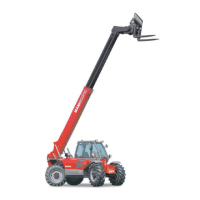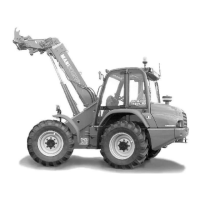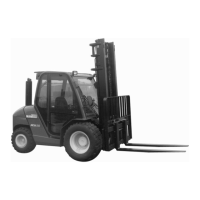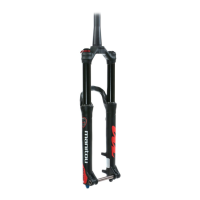B
B - - AATTTTACHMENACHMENT T WITHWITHOUT OUT HYDRAHYDRAULICS ULICS AND AND HYDRAUHYDRAULIC LIC LOCKILOCKING NG DEVICDEVICEE
(OPTION)(OPTION)
TAKING UP AN ATTACHMENTTAKING UP AN ATTACHMENT
-- Ensure that the attachment is in a Ensure that the attachment is in a position facilitating the locking to the carriage. If it isposition facilitating the locking to the carriage. If it is
not correctly oriented, take the necessary precautions in order to move it safely.not correctly oriented, take the necessary precautions in order to move it safely.
- Check that the rods on the locking cylinder are retracted (fig. A).- Check that the rods on the locking cylinder are retracted (fig. A).
-- Place the lift truck with the jib fully lowered in front of and parallel to the Place the lift truck with the jib fully lowered in front of and parallel to the attachment, tiltattachment, tilt
the carriage forwards (fig. B).the carriage forwards (fig. B).
-- Bring the carriage under the locking tube of the attBring the carriage under the locking tube of the attachment, slightly lift the jib, incline theachment, slightly lift the jib, incline the
carriage backwards in order to position the attachment (fig. C).carriage backwards in order to position the attachment (fig. C).
- Lift the attachment off the ground to facilitate locking.- Lift the attachment off the ground to facilitate locking.
HYDRAULIC LOCKINGHYDRAULIC LOCKING
-- Put the valve in position A (fig. D), that is to sPut the valve in position A (fig. D), that is to say, thay, the hydraulic circuit of the attachmente hydraulic circuit of the attachment
locking open.locking open.
-- Switch button 1 (fig. E) of Switch button 1 (fig. E) of the distributor lever forwards to completely lock the attachmentthe distributor lever forwards to completely lock the attachment
on the carriage.on the carriage.
-- Close the valve in position B (fig. D), that is to sayClose the valve in position B (fig. D), that is to say, the hydraulic circuit of the attachment, the hydraulic circuit of the attachment
locking closed.locking closed.
Always close the valve in position B (fig. D) after locking the attachment, in order to avoid accidentalAlways close the valve in position B (fig. D) after locking the attachment, in order to avoid accidental
unlocking and to use unlocking and to use the attachment completely safely.the attachment completely safely.
HYDRAULIC RELEASINGHYDRAULIC RELEASING
-- Put the valve in position A (fig. D), that is to sPut the valve in position A (fig. D), that is to say, thay, the hydraulic circuit of the attachmente hydraulic circuit of the attachment
locking open.locking open.
-- Switch button 1 (fig. E) of the distributoSwitch button 1 (fig. E) of the distributor lever backwards to completely release ther lever backwards to completely release the
attachment.attachment.
LAYING AN ATTACHMENTLAYING AN ATTACHMENT
-- Proceed in the reverse order of paragraph TAKING UP AN AProceed in the reverse order of paragraph TAKING UP AN ATTACHMENT while making sureTTACHMENT while making sure
you place the attachment flat on the you place the attachment flat on the ground and in closed position.ground and in closed position.
INACTIVATE THE HYDRAULIC RELEASE CONTROLINACTIVATE THE HYDRAULIC RELEASE CONTROL
You can change an attachment without leaving the control post, by cutting the electricityYou can change an attachment without leaving the control post, by cutting the electricity
supply to the hydraulic control.supply to the hydraulic control.
- Leave the valve in position A (fig. D).- Leave the valve in position A (fig. D).
-- Use switch 2 (fig. F) to cut the electricity supply to the hyUse switch 2 (fig. F) to cut the electricity supply to the hydraulic control. The circuit is outdraulic control. The circuit is out
of action when indicator 3 (fig. of action when indicator 3 (fig. F) is on.F) is on.
Always cut the electrical power to the Always cut the electrical power to the circuit using switch 2 (fig. F) circuit using switch 2 (fig. F) after each change of attachment toafter each change of attachment to
avoid involuntary release avoid involuntary release and use the attachment in and use the attachment in complete safetycomplete safety..
BB
CC
AA
DD
AA
BB
EE
11
FF
22

